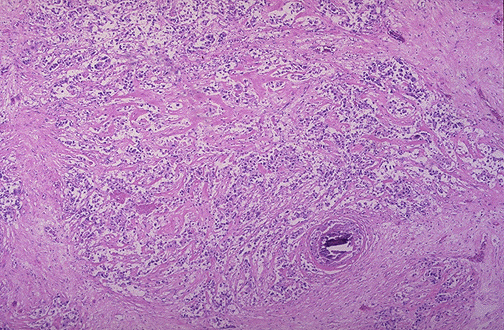
Breast: Carcinoma

Click to see other slides: [1]
A
55 yr old postmenopausal woman was found to have a 2.5cm diameter hard,
irregular, non-mobile mass in the right breast.
1.
What are differential diagnoses?
Breast
carcinoma
Fibroadenoma
(unlikely because it is regular and mobile)
Fibrocystic
change
2.
What
other findings on physical examination would help you narrow down your
differentials to the most likely diagnosis?
Dimpling
and retraction of skin �
peau d�orange
Retraction
of nipple
3.
List
the histological features for calling this a
Malignant
tumour:
-
loss of lobulocentric architecture
-
invasion into stroma
-
sheets, solid nests of pleomorphic
cells
-
pleomorphic, hyperchromatic nuclei
-
mitotic figures
-
one cell type, no myoepithelial
cells
of
ductal origin: some
malignant cells form ductal structures
4.
List
the 2 commonest histological types of breast cancer?
Ductal
carcinoma (79%)
Lobular
carcinoma (10%)
5.
List
the histological parameters of prognostic value.
Histological
subtype (tubular and colloid carcinomas have an exceptionally good prognosis)
Tumour
grade (>80% with grade I tumour survive for 16 yrs, compared with <60% in
grade II and III)
Evidence
of local or vascular invasion (presence of invasion signals metastases)
6.
What is the clinical significance of immunohistochemical demonstration of
hormone receptors in the tumour cells?
Slightly
better prognosis
Respond
to hormonal therapy
7.
Name
the lymph nodes commonly affected by this cancer?
Axillary
Internal thoracic
Supraclavicular
<< PREVIOUS INDEX NEXT SLIDE >>
Copyright � Joseph Ong 2003